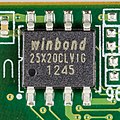| iBoot | |
|---|---|
 | |
| Developer(s) | Apple Inc. |
| Initial release | June 29, 2007 |
| Stable release | iBoot-11881.80.57~171 (RELEASE, iOS 18.3 RC and iOS 18.3.1) |
| Preview release | iBoot-11881.80.57~107 (RELEASE, iOS 18.3 beta 1) |
| Operating system | Darwin, macOS, [1] iPadOS and iOS [2] |
| Platform | x86, ARM |
| Type | Boot loader |
| License | Proprietary software |
iBoot is the stage 1 and stage 2 bootloader for iPhones, iPads, Apple silicon-based Macs, and the T2 chip in Intel-based Macs with such a chip. [3] [4] Compared with its predecessor, iBoot improves authentication performed in the boot chain. [2]
Contents
- Build styles
- Meanings
- Features
- Memory safety
- Source code leak incident
- History
- See also
- References
- External links
For Intel-based Macs with a T2 chip, the boot process starts by running code on the T2 chip from the boot ROM. That boot ROM loads and runs iBoot onto the T2 chip; iBoot loads the bridgeOS operating system onto the T2 chip and starts it; bridgeOS loads the UEFI firmware; UEFI firmware starts the main Intel processor and completes the Power-On Self Test process. The UEFI firmware loads boot.efi, which loads and starts the macOS kernel. [4] For Intel-based Macs with a T2 chip, the UEFI firmware may be called iBoot UEFI.
For iPhones, iPads, and Apple silicon-based Macs, the boot process starts by running the device's boot ROM, which is integrated into the device's SoC. On iPhones and iPads with A9 or earlier A-series processors, the boot ROM loads the Low-Level Bootloader (LLB), which is the stage 1 bootloader and loads iBoot, and LLB is stored on an EEPROM; on iPhones and iPads with A10 or later processors, as well as Apple silicon Macs, the boot ROM loads iBoot, and LLB and iBoot are stored on NAND flash or internal SSD, which is a NOR-less boot flow. [5] [6] If all goes well, iBoot will then proceed to load the iOS, iPadOS or macOS kernel as well as the rest of the operating system. [7] [8] [9] If iBoot fails to load or fails to verify iOS, iPadOS or macOS, the bootloader jumps to DFU (Device Firmware Update) [10] mode; otherwise it loads the remaining kernel modules. [2] [11]
Once the kernel and all drivers necessary for booting are loaded, the boot loader starts the kernel’s initialization procedure. At this point, enough drivers are loaded for the kernel to find the root device. [12]

